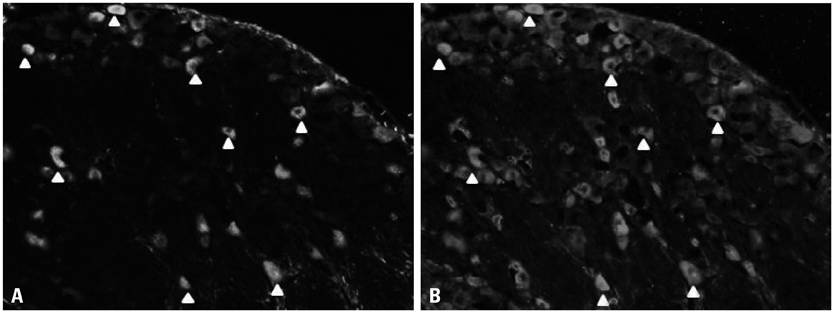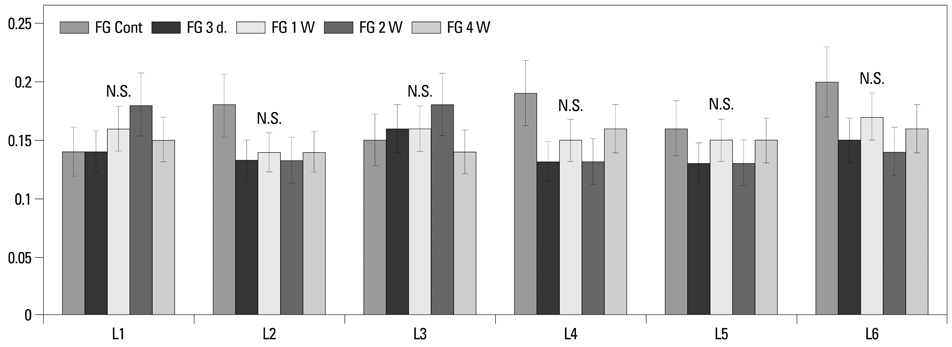Yonsei Med J.
2014 Jan;55(1):185-190. 10.3349/ymj.2014.55.1.185.
Transient Receptor Potential Vanilloid 1-Immunoreactive Innervation Increases in Fractured Rat Femur
- Affiliations
-
- 1Department of Orthopaedic Surgery, Graduate School of Medicine, Chiba University, Chiba, Japan. sohtori@faculty.chiba-u.jp
- KMID: 1779904
- DOI: http://doi.org/10.3349/ymj.2014.55.1.185
Abstract
- PURPOSE
Pain from vertebral or femoral neck fractures is a particularly important problem in clinical orthopaedics. Transient receptor potential vanilloid 1 (TRPV1) is a ligand-gated nonselective cation channel, and there are recent reports on an association between bone pain and TRPV1. However, an increase in TRPV1 activity has not been reported following femoral fracture.
MATERIALS AND METHODS
We applied a neurotracer [Fluoro-gold (FG)] onto femur to detect dorsal root ganglia (DRGs) innervating the cortex of the femur in 30 Sprague Dawley rats. Seven days after application, a closed mid-diaphyseal fracture of the femur was performed. FG labeled TRPV1-immunoreactive (ir) DRGs innervating the femur were examined in nonfractured controls, and 3 days, 1 week, 2 weeks, and 4 weeks after fracture. We evaluated bone healing of the femur and compared the ratio of TRPV1-ir DRG neurons innervating the femur at the time points.
RESULTS
Four weeks after fracture, complete bone union was observed. There was no significant difference in the ratio of FG labeled DRG neurons to total DRG neurons at each time point. The percentages of TRPV1-ir neurons in DRGs innervating the femur at 3 days and 1 week after fracture were significantly higher than those in control, 2 weeks, and 4 weeks after fracture (p<0.05).
CONCLUSION
Fracture induced an increase of TRPV1-ir neurons in DRGs innervating the fractured femur within 3 days, and decreased during bone healing over 4 weeks. These findings show that TRPV1 may play a role in sensory sensation of bone fracture pain.
Keyword
MeSH Terms
Figure
Reference
-
1. Dennison E, Mohamed MA, Cooper C. Epidemiology of osteoporosis. Rheum Dis Clin North Am. 2006; 32:617–629.
Article2. Mach DB, Rogers SD, Sabino MC, Luger NM, Schwei MJ, Pomonis JD, et al. Origins of skeletal pain: sensory and sympathetic innervation of the mouse femur. Neuroscience. 2002; 113:155–166.
Article3. Mantyh WG, Jimenez-Andrade JM, Stake JI, Bloom AP, Kaczmarska MJ, Taylor RN, et al. Blockade of nerve sprouting and neuroma formation markedly attenuates the development of late stage cancer pain. Neuroscience. 2010; 171:588–598.
Article4. Yang CJ, Wang XW, Li X, Wu GC, Wang YQ, Mao-Ying QL. A rat model of bone inflammation-induced pain by intra-tibial complete Freund's adjuvant injection. Neurosci Lett. 2011; 490:175–179.
Article5. Jimenez-Andrade JM, Mantyh WG, Bloom AP, Freeman KT, Ghilardi JR, Kuskowski MA, et al. The effect of aging on the density of the sensory nerve fiber innervation of bone and acute skeletal pain. Neurobiol Aging. 2012; 33:921–932.
Article6. Freeman KT, Koewler NJ, Jimenez-Andrade JM, Buus RJ, Herrera MB, Martin CD, et al. A fracture pain model in the rat: adaptation of a closed femur fracture model to study skeletal pain. Anesthesiology. 2008; 108:473–483.7. Koewler NJ, Freeman KT, Buus RJ, Herrera MB, Jimenez-Andrade JM, Ghilardi JR, et al. Effects of a monoclonal antibody raised against nerve growth factor on skeletal pain and bone healing after fracture of the C57BL/6J mouse femur. J Bone Miner Res. 2007; 22:1732–1742.
Article8. Jimenez-Andrade JM, Martin CD, Koewler NJ, Freeman KT, Sullivan LJ, Halvorson KG, et al. Nerve growth factor sequestering therapy attenuates non-malignant skeletal pain following fracture. Pain. 2007; 133:183–196.
Article9. Yasui M, Shiraishi Y, Ozaki N, Hayashi K, Hori K, Ichiyanagi M, et al. Nerve growth factor and associated nerve sprouting contribute to local mechanical hyperalgesia in a rat model of bone injury. Eur J Pain. 2012; 16:953–965.
Article10. Tominaga M, Caterina MJ, Malmberg AB, Rosen TA, Gilbert H, Skinner K, et al. The cloned capsaicin receptor integrates multiple pain-producing stimuli. Neuron. 1998; 21:531–543.
Article11. Guo A, Vulchanova L, Wang J, Li X, Elde R. Immunocytochemical localization of the vanilloid receptor 1 (VR1): relationship to neuropeptides, the P2X3 purinoceptor and IB4 binding sites. Eur J Neurosci. 1999; 11:946–958.
Article12. Yu L, Yang F, Luo H, Liu FY, Han JS, Xing GG, et al. The role of TRPV1 in different subtypes of dorsal root ganglion neurons in rat chronic inflammatory nociception induced by complete Freund's adjuvant. Mol Pain. 2008; 4:61.
Article13. Niiyama Y, Kawamata T, Yamamoto J, Omote K, Namiki A. Bone cancer increases transient receptor potential vanilloid subfamily 1 expression within distinct subpopulations of dorsal root ganglion neurons. Neuroscience. 2007; 148:560–572.
Article14. Niiyama Y, Kawamata T, Yamamoto J, Furuse S, Namiki A. SB366791, a TRPV1 antagonist, potentiates analgesic effects of systemic morphine in a murine model of bone cancer pain. Br J Anaesth. 2009; 102:251–258.
Article15. Brown MF, Hukkanen MV, McCarthy ID, Redfern DR, Batten JJ, Crock HV, et al. Sensory and sympathetic innervation of the vertebral endplate in patients with degenerative disc disease. J Bone Joint Surg Br. 1997; 79:147–153.
Article16. Orita S, Ohtori S, Koshi T, Yamashita M, Yamauchi K, Inoue G, et al. The effects of risedronate and exercise on osteoporotic lumbar rat vertebrae and their sensory innervation. Spine (Phila Pa 1976). 2010; 35:1974–1982.
Article17. Luo D, Zhang YW, Peng WJ, Peng J, Chen QQ, Li D, et al. Transient receptor potential vanilloid 1-mediated expression and secretion of endothelial cell-derived calcitonin gene-related peptide. Regul Pept. 2008; 150:66–72.
Article18. Jimenez-Andrade JM, Bloom AP, Mantyh WG, Koewler NJ, Freeman KT, Delong D, et al. Capsaicin-sensitive sensory nerve fibers contribute to the generation and maintenance of skeletal fracture pain. Neuroscience. 2009; 162:1244–1254.
Article19. Salisbury E, Rodenberg E, Sonnet C, Hipp J, Gannon FH, Vadakkan TJ, et al. Sensory nerve induced inflammation contributes to heterotopic ossification. J Cell Biochem. 2011; 112:2748–2758.
Article20. Idris AI, Landao-Bassonga E, Ralston SH. The TRPV1 ion channel antagonist capsazepine inhibits osteoclast and osteoblast differentiation in vitro and ovariectomy induced bone loss in vivo. Bone. 2010; 46:1089–1099.
Article21. Murnaghan M, Li G, Marsh DR. Nonsteroidal anti-inflammatory drug-induced fracture nonunion: an inhibition of angiogenesis? J Bone Joint Surg Am. 2006; 88:Suppl 3. 140–147.
Article22. Giannoudis PV, MacDonald DA, Matthews SJ, Smith RM, Furlong AJ, De Boer P. Nonunion of the femoral diaphysis. The influence of reaming and non-steroidal anti-inflammatory drugs. J Bone Joint Surg Br. 2000; 82:655–658.23. Ensrud KE, Blackwell T, Mangione CM, Bowman PJ, Bauer DC, Schwartz A, et al. Central nervous system active medications and risk for fractures in older women. Arch Intern Med. 2003; 163:949–957.
Article24. King T, Vardanyan A, Majuta L, Melemedjian O, Nagle R, Cress AE, et al. Morphine treatment accelerates sarcoma-induced bone pain, bone loss, and spontaneous fracture in a murine model of bone cancer. Pain. 2007; 132:154–168.
Article
- Full Text Links
- Actions
-
Cited
- CITED
-
- Close
- Share
- Similar articles
-
- Increase of TRPV1-Immunoreactivity in Dorsal Root Ganglia Neurons Innervating the Femur in a Rat Model of Osteoporosis
- Expression of vesicular glutamate transporter in transient receptor potential vanilloid 1-positive neurons in the rat trigeminal ganglion
- Transient Receptor Potential Vanilloid Type-1 Channel in Cardiometabolic Protection
- The Role of Transient Receptor Potential Channel in Pain
- Changes in transient receptor potential vanilloid 1 and transient receptor potential vanilloid 4 in patients with lower urinary tract dysfunction





